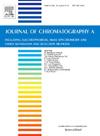了解寡核苷酸通断保留机制的基本原理及其在高通量分析中的应用。
IF 3.8
2区 化学
Q1 BIOCHEMICAL RESEARCH METHODS
引用次数: 0
摘要
离子对反相液相色谱(IP-RPLC)被公认为分析治疗性寡核苷酸(ONs)的黄金标准。最近的研究表明,寡核苷酸在 IP-RPLC 中表现出开关保留行为,这意味着乙腈(ACN)比例的微小变化都会对保留产生重大影响。然而,这种行为最初仅在单一流动相条件下得到证实。本研究的目的是通过测量各种流动相条件下的 S 值(保留模型的斜率,log k vs.%ACN )来深入了解 ON 洗脱行为。我们系统地计算了20聚合物和100聚合物模型ON在不同条件下的S值,包括不同的IP试剂、IP浓度、流动相pH值、色谱柱温度和两种不同的缓冲酸。我们证明,这些流动相条件对 S 值的影响顺序如下:IP 疏水性 > IP 浓度 > 色谱柱温度 > 缓冲酸 > 流动相 pH 值。对这一趋势的主要解释是,降低离子对保留机制的流动相条件(如低 IP 疏水性或浓度)将增强 ACN 对保留的影响,从而导致更高的 S 值。在研究的第二部分,我们利用这一知识开发了两种治疗性寡核苷酸的超快速分离技术:一种是没有硫代磷酸酯(PS)修饰的 20 聚体反义寡核苷酸 (ASO),另一种是包含某些 PS 修饰的大型单导 RNA (sgRNA)。对流动相条件进行了优化,以最大限度地提高 S 值,同时防止非对映异构体的分离。值得注意的是,要从超短柱的使用中获益,S 值至少要达到 30。使用这种方法,只需使用 5 毫米长的色谱柱,就能在一分钟内成功分离主要物种(ASO 和 sgRNA)和相关杂质。本文章由计算机程序翻译,如有差异,请以英文原文为准。
Understanding the fundamentals of the on-off retention mechanism of oligonucleotides and their application to high throughput analysis
Ion-pair reversed-phase liquid chromatography (IP-RPLC) is clearly recognized as the gold standard for analyzing therapeutic oligonucleotides (ONs). Recent studies have shown that ONs exhibit an on-off retention behavior in IP-RPLC, meaning that minor changes in acetonitrile (ACN) proportion can significantly impact retention. However, this behavior was initially demonstrated with only a single mobile phase condition. The aim of this study is to gain a deeper understanding of ON elution behavior by measuring the S values (slope of the retention model, log k vs.%ACN) across a broad range of mobile phase conditions. We systematically calculated the S values for both a 20-mer and 100-mer model ON under various conditions, including different IP reagents, IP concentrations, mobile phase pH, column temperatures, and two different buffering acids. We demonstrated that these mobile phase conditions impact the S values in the following order: IP hydrophobicity > IP concentration > column temperature > buffering acid > mobile phase pH. The main explanation for this trend is that mobile phase conditions that reduce the ion-pair retention mechanism (such as low IP hydrophobicity or concentration) will enhance the impact of% ACN on retention, leading to higher S values.
In the second part of the study, this knowledge was used to develop ultra-fast separations for two therapeutic oligonucleotides: a 20-mer antisense oligonucleotide (ASO) without phosphorothioate (PS) modifications and a large single guide RNA (sgRNA) that includes certain PS modifications. The mobile phase conditions were optimized to maximize S values, while preventing the separation of diastereomers. It is important to notice that an S-value of at least 30 is required to benefit from the use of ultra-short columns. This approach allows the successful separation of the main species (ASO and sgRNA) and related impurities in less than one minute using a 5 mm length column.
求助全文
通过发布文献求助,成功后即可免费获取论文全文。
去求助
来源期刊

Journal of Chromatography A
化学-分析化学
CiteScore
7.90
自引率
14.60%
发文量
742
审稿时长
45 days
期刊介绍:
The Journal of Chromatography A provides a forum for the publication of original research and critical reviews on all aspects of fundamental and applied separation science. The scope of the journal includes chromatography and related techniques, electromigration techniques (e.g. electrophoresis, electrochromatography), hyphenated and other multi-dimensional techniques, sample preparation, and detection methods such as mass spectrometry. Contributions consist mainly of research papers dealing with the theory of separation methods, instrumental developments and analytical and preparative applications of general interest.
 求助内容:
求助内容: 应助结果提醒方式:
应助结果提醒方式:


